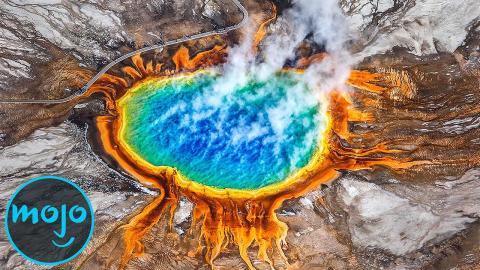10 Scientific Discoveries You Should Be Worried About

#10: Microplastics in Water
Many people worry about formaldehyde in water, as high concentrations can cause various health effects. But what may be even scarier are the amount of microplastics. These are very small pieces of plastic that enter natural water sources - and maybe even our brains. A study conducted by South Korea’s Daegu Gyeongbuk Institute of Science and Technology found that microplastics can pass the mice’s blood-brain barrier, which is used to keep external matter out of the important organ. Even worse, a study published in Environment International showed that over 75% of their human test subjects had microplastics in their blood. These plastics can lodge themselves in organs and cause cell death, which may result in increased cancer rates. And, just maybe, breach the human blood-brain barrier too…
#9: Prions
The more we learn about prions, the scarier they sound. A prion is a type of abnormal protein that “infects” all nearby proteins, thereby causing a chain reaction. It’s unclear how a prion is made, but we know its devastating consequences. Prions cause neurodegenerative conditions called TSEs, which are both fatal and incurable. In humans, these include Gerstmann–Sträussler–Scheinker syndrome, fatal insomnia, and Creutzfeldt–Jakob disease. While these are extremely rare, more common diseases like ALS, Alzheimer’s, and Parkinson’s may also be linked to prion accumulation. The chances of getting a misfolded protein like this are very slim, but it’s terrifying to know that a rogue one could lead to incurable wasting and eventual death.
#8: Limnic Eruptions
The understanding behind limnic eruptions is relatively new, as only two have been observed in modern history. Both occurred in Cameroon, the first in 1984 and the second in 1986. A limnic eruption is when carbon dioxide rises from a lake and erupts into the atmosphere in the form of a gas cloud. This cloud then displaces the oxygen in the air and smothers everything in its path. The 1984 eruption led to the loss of 37 , and the second resulted in an estimated 1,700. A lake between Rwanda and the Democratic Republic of the Congo called Lake Kivu has been showing signs of a potential limnic eruption. If this occurs, the event could kill millions.
#7: Lingering Radioactivity
For as long as we’ve been studying radiation, its potential has terrified us. The concept of radioactivity was pioneered by Polish physicist Marie Curie, who won a Nobel Prize for her efforts. However, her work had seemingly deadly consequences, and she died at 66 from aplastic anemia. Her papers are still dangerously radioactive and kept in special boxes to prevent contamination. This in turn has raised questions about lingering radioactivity. For example, Bikini Atoll has not been resettled, as the radiation still affects local food supplies. Even worse is Ukraine’s Chernobyl Exclusion Zone, the off-limits area that was created in the aftermath of the Chernobyl disaster. While the area is safe to visit for brief periods, it may not be habitable for thousands of years.
#6: Microbes in Glaciers
2022 was a terrifying year for climate change. As the situation continues to worsen, we received some disturbing news about our melting glaciers. New microbes that are trapped inside the ice are slowly being released as the glaciers melt. There are thousands upon thousands of microbes in the water, most of which are unknown to science and some of which could be pathogenic in nature. Should these microbes find their way into local water supplies, they could spark new and devastating pandemics. Unfortunately, this may be even worse than it sounds. Recent research has also proved that antibiotic resistance is on the rise, meaning bacterial infections are getting harder to treat. This could be a perfect storm of destruction…
#5: The Asteroid That Nearly Hit Us
Top 10 Greatest Scientific Discoveries of All Time
If one thing has the power to literally destroy the Earth, it’s an asteroid. And unfortunately, asteroids can be difficult to find. On September 17, 2021, scientists noticed that a large asteroid had passed very close to Earth the previous day. Named 2021 SG, the asteroid was up to 308 feet in diameter and was traveling at over 50, 000 miles per hour. However, astronomers never spotted it because it came from the direction of the sun. This asteroid was about four times larger than the famous Chelyabinsk meteor that exploded over Russia in 2013, breaking windows and injuring 1,500. That meteor was also obscured by the sun. Makes you wonder how many other dangerous rocks are hurtling straight for us…
#4: The Dwindling Number of Bees
Top 23 Scientific Discoveries of Each Year (2000 - 2022)
Insects are dying off at an alarming rate. One analysis published in Biological Conservation estimates that about 30 percent of all insects are currently endangered. Their collective mass is also declining at a rate of 2.5% per year. If insects continue to die off, it will likely cause widespread devastation on global ecosystems and agriculture. Bees are in particular danger. A 2021 study published in One Earth indicates that one-quarter of the world’s bee species hasn’t been seen or reported in thirty years. Things like farming practices and climate change have significantly decreased the global bee population, and these insects are paramount to food production. Without them, staples like fruits and vegetables may become increasingly rare.
#3: The Supervolcano Under Yellowstone
Top 10 Biggest Scientific Discoveries of 2022
Many media outlets have exaggerated reports about the Yellowstone Caldera. Perhaps the most famous - and feared - volcano in America, Yellowstone last erupted over 640,000 years ago. Should it do so again, the global climate would be altered and catastrophic damage could occur across the United States. Most of the information regarding Yellowstone was researched by a scientist named Bob Christiansen, whose work spanned the 1960s and ‘70s. It’s a myth that Yellowstone is “overdue” to erupt, and the chances of it doing so again are actually quite miniscule. In fact, many experts are convinced that Yellowstone will never experience another super eruption. But the possibility still exists, and that’s a terrifying thought.
#2: We’re In a Mass Extinction
The 10 Most Disturbing Scientific Discoveries Ever
It’s not just the insects that are disappearing. Research has shown that the world as we know it today is currently in the midst of what is called the “Holocene extinction.” This event is hitting pretty much every living being, from fungi all the way to mammals and fish. The primary driver of this extinction event is the ever-growing human population and its effects on habitat destruction. Humanity continuously razes forests, over-fishes the oceans, and focuses extensively on meat production, to name just a few current problems. A 2011 study published in the journal Nature found that 75% of all animal species could be extinct by 2300.
#1: The Devastating Effects of Climate Change
Top 10 Scientific Advancements That Could END THE WORLD
Scientists are hard at work researching climate change and the highly destructive impact that it will have on future generations. Some consequences are currently being observed, like rising global temperatures, damaging wildfires, and melting glaciers. It’s scary, but what’s even scarier is that this is just the start. The worst is yet to come, according to the continued National Climate Assessment Reports. These effects include more fierce hurricanes, brutally hot temperatures and resulting droughts, increased precipitation in the north, and rising sea levels. In fact, some believe that the oceans may rise as much as eight feet by just 2100. This in turn will wreak catastrophic harm on coastal cities. Frankly, it’s not looking very good…






